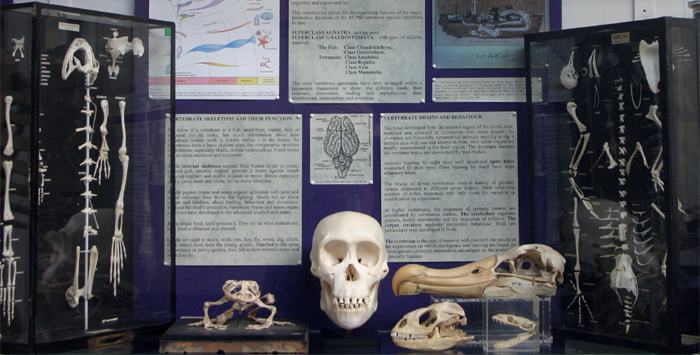
VERTEBRATE ANATOMY AND BEHAVIOUR
VERTEBRATE SKELETONS AND THEIR FUNCTION
We know if a vertebrate is a fish, amphibian, reptile, bird or mammal by its looks, but much information about how vertebrate bodies work is hidden within - in the bones. As vertebrates have a basic skeletal plan, the comparative structure of skeletons, especially skulls, reveals relationships. Fossil bones tell us about ancestors and evolution.
Their internal skeletons support their bodies in air or water; protect soft, internal organs; provide a frame against which muscles contract and enable animals to move. Bones especially skulls, jaws, teeth and limbs, tell us about lifestyles.

The internal skeletons of the different classes of vertebrates and the skulls and vertebral columns, that protect their brains and dorsal nerve cords, are represented by (from left to right): a ‘disarticulated’ skeleton and a mounted or ‘articulated’ skeleton of two bullfrogs (amphibians); a skull of a chimpanzee (mammals); a skull of an albatross (birds), a skull of a lizard and a snake (reptiles), a ‘disarticulated’ skeleton of a pigeon (birds).
Skulls protect brains and sense organs; articulate with jaws and spinal columns; bear horns for fighting. Skulls tell us about senses and intellect; about feeding, behaviour and movement. Without the skull's protection, vertebrate brains and sense organs could not have developed to the advanced levels found today.
Jaws obtain food; teeth process it. They tell us what animals eat; how food is obtained and chewed.
Limbs are used to move, walk, run, hop, fly, swim, dig, climb, fight, obtain food, hold the young, groom. Attached to the spine via pectoral or pelvic girdles, they tell us how animals move and what they do.
VERTEBRATE BRAINS AND BEHAVIOUR
The brain developed from the anterior region of the spinal cord, modified and enlarged in connexion with sense organs. As chordates are bilaterally symmetrical animals moving along a definite axis with one end always in front, their sense organs are mainly concentrated in the head region. The dominant features of vertebrate brains are seen in wax models.
Animals hunting by sight have well developed optic lobes connected to their eyes; those hunting by smell have large olfactory lobes.
The brains of lower vertebrates consist mainly of primary centres connected to different sense organs. Their behaviour consists of reflex responses with little room for variation or modification by experience.
In higher vertebrates, the responses of primary centres are coordinated by correlation centres. The cerebellum regulates posture, bodily movements and the execution of reflexes. The corpus striatum mediates instinctive behaviour. Both are particularly well developed in birds.
The cerebrum is the seat of memory and considers the results of the experiences on which intelligence and learning are based. The more complicated behaviour of tetrapods over other vertebrates is mediated by an increasingly large cerebrum. Its development conferred tremendous advantages on the mammals, especially humans.






